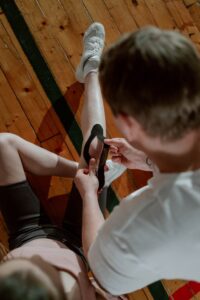Happy New Year!
The most common New Year’s resolution is probably starting an exercise routine or exercising more.
Have you recently started an exercise routine? Or are you the one that increased their exercise? Have you begun to notice that your knees are now bothering you?
If you are having pain with exercises like squats, lunges, stairs, or running you may be experiencing patellofemoral pain. Patellofemoral pain is commonly called “runners knee”.
At your knee joint, the knee cap (patella) normally moves along the thigh bone (femur) when you bend and straighten your knee. With patellofemoral pain, the normal movement can be overloaded, like when starting a new workout that your body is not used to. Or the movement can be disrupted, causing your knee cap to not glide properly. Either scenario can lead to irritation and pain.
Patellofemoral pain presents as pain along the inside and front of your kneecap.

But hold on there…this is not due to your knee alone, as the knee tends to be at the mercy of the hip and the foot.
How can you tell if it’s Patello-Femoral Pain?
The most common symptom of patello-femoral pain occurs when the knee is bending or in a bent position for an extended period of time. The pain can also cause complaints of buckling of the knee or feeling unstable.
If these describe what you have been feeling, here is a little test you can try.
Stand in front of a mirror and watch how you squat. Do your knees collapse inward? This is a common presentation with patellofemoral pain.
But hold on there…this is not due to your knee alone, as the knee tends to be at the mercy of the hip and the foot. Notice that your knee mostly moves straight forward and backward, and does very little rotation. Rotation is the job of your foot/ankle and hip
Do you have flat feet? Being flat footed allows your lower leg to rotate inward, which causes a rotation at your knee, which can lead to patello-femoral pain.
Tightness or weakness at your hip can also cause your thigh bone to rotate inwards, again leading to rotation through the knee.
Good News: Your knees can be improved.
Here are a couple of quick changes that pay off big.
First, make sure you are in the correct shoes. Go to a reputable store (the local running stores are a good example) and get fitted for the correct shoe for your foot type. I won’t go into all of that detail here, as that could be a doctoral dissertation.
Second, strengthening your hips can have a huge impact on your knees (even if they aren’t bothering you right now)! Supplement your normal routine with the following exercises to strengthen your hip and add stability to your knees.
Here are three basic hip strengthening exercises to get you started.
Lastly, you might need to modify your exercise routine. This does not mean complete rest. While complete rest will stop the pain, you need to address the mechanical issues that are causing the pain. Otherwise, you risk having the pain return when you resume your normal routine.
Have a PT observe your squatting and lunging techniques. You may just need to make some simple adjustments.
While you might need to limit some activity for a short time, making these changes should get you back on the trail and exercising safely. As a general rule, if an exercise or movement doesn’t bother you while you’re doing it, then proceed!
You can reach those New Year’s goals with a little tuning of your workout.
Archives
- March 2024
- February 2024
- January 2024
- October 2023
- September 2023
- April 2023
- December 2022
- November 2022
- October 2022
- August 2022
- July 2022
- June 2022
- May 2022
- March 2022
- January 2022
- April 2021
- February 2021
- January 2021
- September 2020
- August 2020
- July 2020
- June 2020
- April 2020
- January 2020
- September 2019
- June 2019
- May 2019
